The Israel-Hamas War is Fueling an ISIS Lone Wolf Resurgence
By Rita Katz | Published 12.29.2023
By its very design, ISIS’ model of terrorism can resurface all too easily, given the right circumstances.

Press conference by Las Vegas Deputy Chief Dori Koren after SITE uncovered an imminent ISIS-inspired plot.
On November 28, SITE Intelligence Group reported on a threat of an imminent attack in Las Vegas. Our team discovered the message in a pro-Islamic State (ISIS) chat group on Element, an instant messenger platform. The post was fitting of the larger deluge of threats against Jewish and other targets we were seeing after Hamas’ October 7 attack against Israel. The user fashioned the message like a communique, stating:
Peace be upon all brothers who see this. I am here to announce that I will be starting lone wolf operations in Las Vegas against the enemies of Allah. I ask you to make Dua for victory. I am a supporter of the Islamic State, and I will make sure the zionists in this city know it.
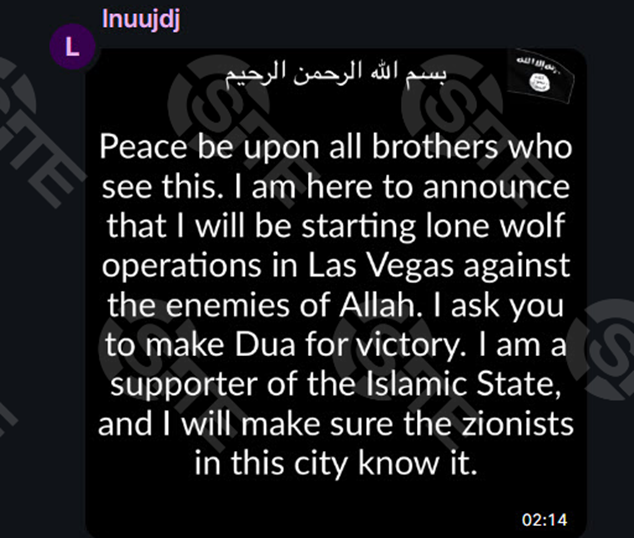
November 28 post by Element user “lnuujdj"
Acting on our information, authorities in Las Vegas foiled the attack and arrested the plotter, who turned out to be a 16-year-old “recent convert to Islam,” per Deputy Chief Dori Koren. Bomb-making instructions and materials found at the teenager’s residence suggest a genuine intention to carry out such an attack.
While the Las Vegas attack was foiled, it was nonetheless another signal of a rising threat many believed subsided.
Prior to October 7, the last lone wolf attack ISIS claimed in the West was the 2020 Vienna shootings. Its media had also become relatively tame, with most of its high-profile commentary leaning less on topical or timely issues, and more on big-picture religious ideals. And regarding October 7, ISIS brands Hamas an apostate organization and is the only jihadist group not to embrace its attack on Israel.
Still, ISIS wasn’t going to pass up the opportunity to capitalize.
Almost every issue of ISIS’ weekly an-Naba newspaper since October 7 has seized on anger across the world over the death tolls in Gaza by inciting generally against Jews, non-Muslims (“kuffar”), and Arab leaders. Issue 412 of an-Naba released October 12, did not mention Hamas by name, but it did demand Muslims support their brethren “in distress in every situation.”
While the Las Vegas attack was foiled, it was nonetheless another signal of a rising threat many believed subsided.
“This brotherhood obligates the believer to support his brother in what afflicts him, the most severe of which is the aggression of the disbelievers against him by killing, imprisoning, or displacing him,” the editorial declared. “This is the motivation for support by which Allah commanded us to fight.”
It also emphasized: “…jihad in kind is obligatory for Muslims if the enemy raids a land and takes away the rule of Islam from it, or if the Muslims are held captive by the disbelievers, or if a Muslim woman is taken captive in the East or the West—all of this out of respect for the sanctity of the Muslim and the necessity of supporting him.”
Even before this an-Naba issue’s release, ISIS’ network of media groups had already begun disseminating quotes from ISIS leaders calling to fight Jews and non-Muslims and promising that fighters have their “eyes on Jerusalem.” Much of this media, including the aforementioned Naba editorial, was translated to an array of languages—including French, English, Urdu, Turkish, and Bengali—and disseminated online.
As with previous years, it was only a matter of time before ISIS’ incitement campaign produced deadly results. On October 16, an ISIS-inspired “man of Tunisian origin” shot and killed two Swedish soccer fans in Brussels. Shortly before being killed by police, the attacker uploaded a self-recorded video online, stating: “I am Abdesalam Jilni Meftah Lassoued, a mujahid for the sake of Allah, Islamic State. Love for love, hate for hate…your brother Absesalam took revenge for the Muslims against three Swedes just now.”
ISIS claimed the shooting the following day. And, as expected, the attack was followed by a blitz of propaganda. Among those on board was Intaj al-Ansar (Ansar Productions), an umbrella of prominent ISIS-linked media groups. Their releases have praised “the brave lion” Lassoued while calling to “kill all the Jews” and “target [enemies] as much as you can.”
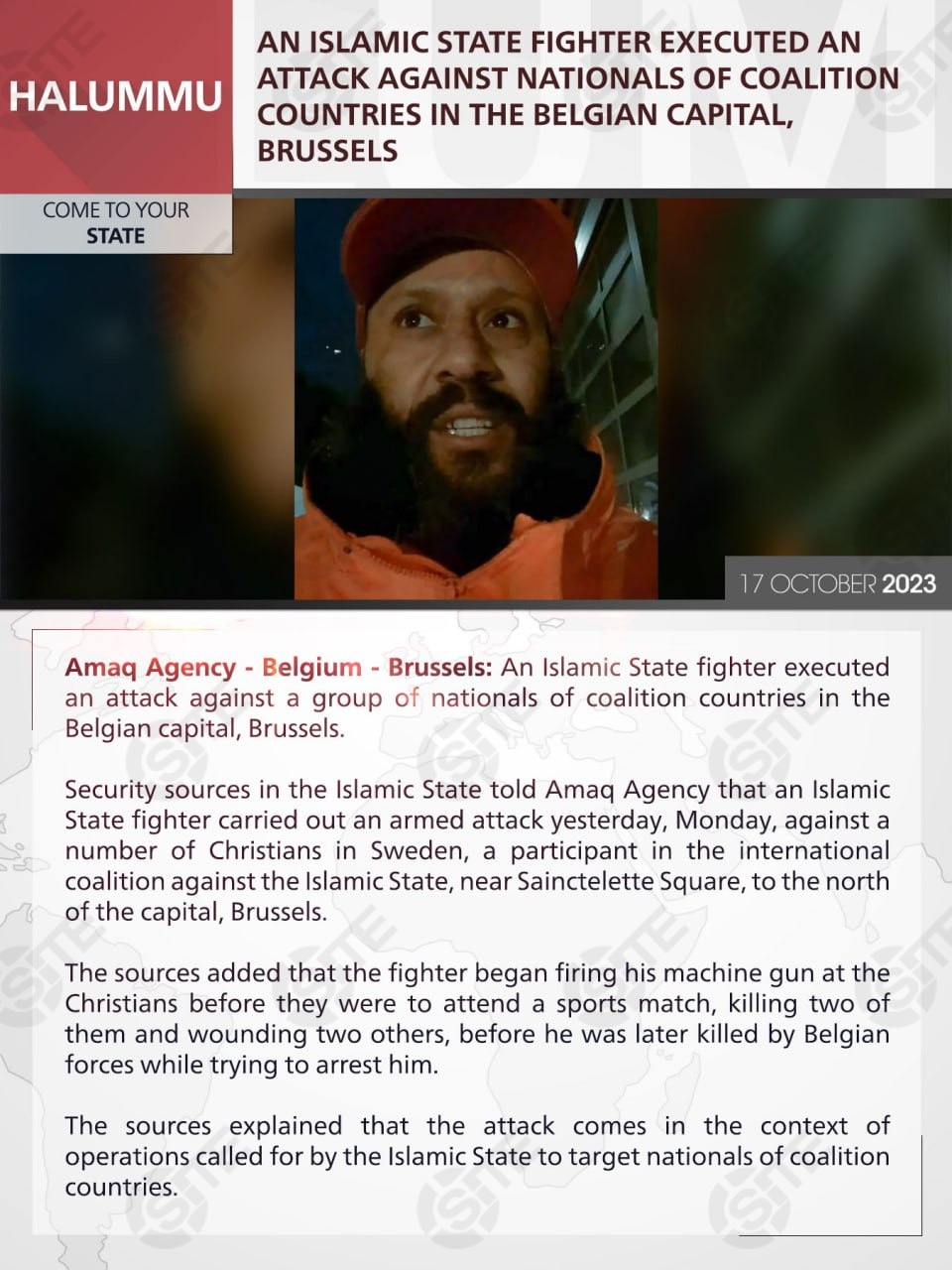
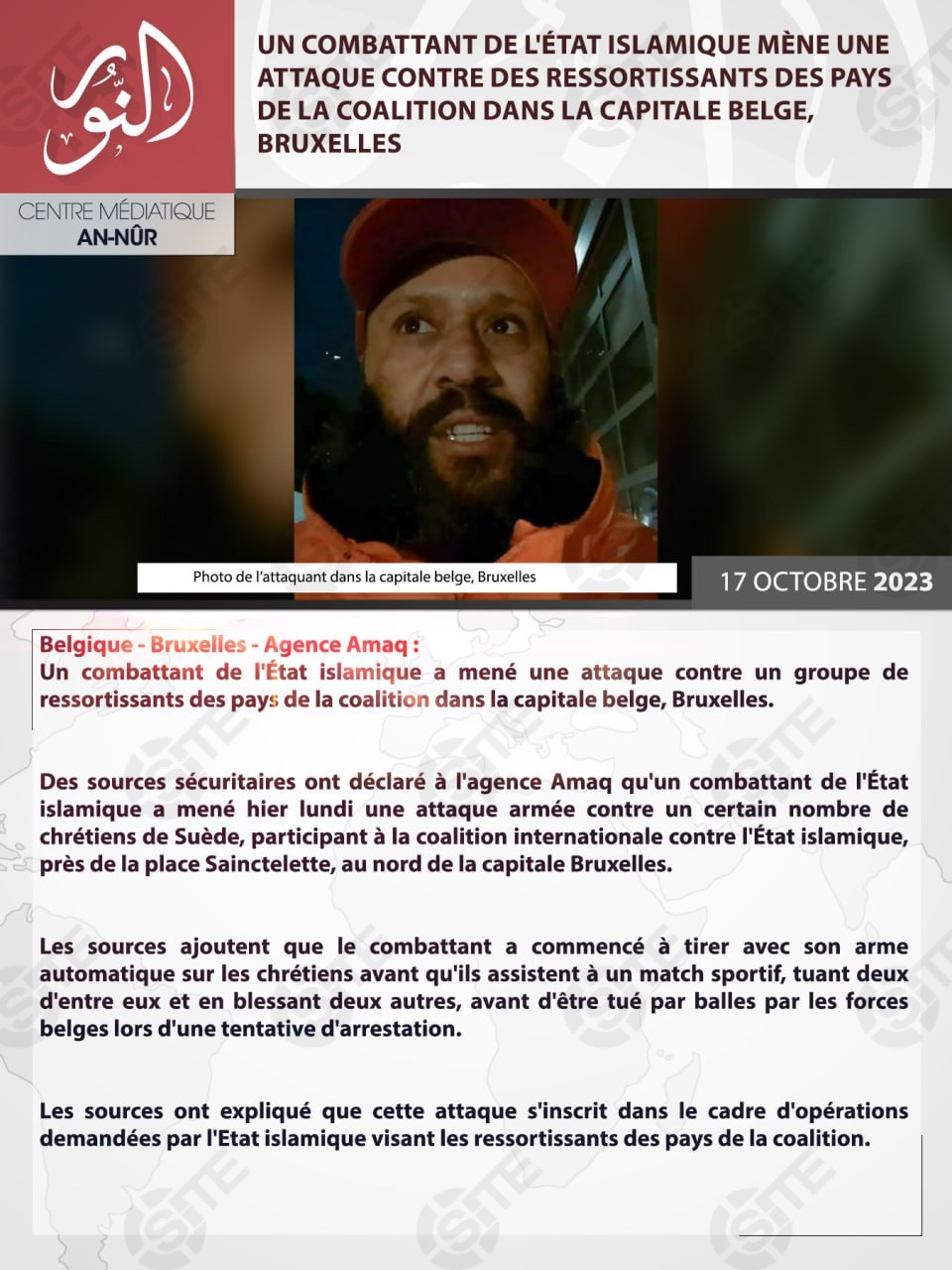
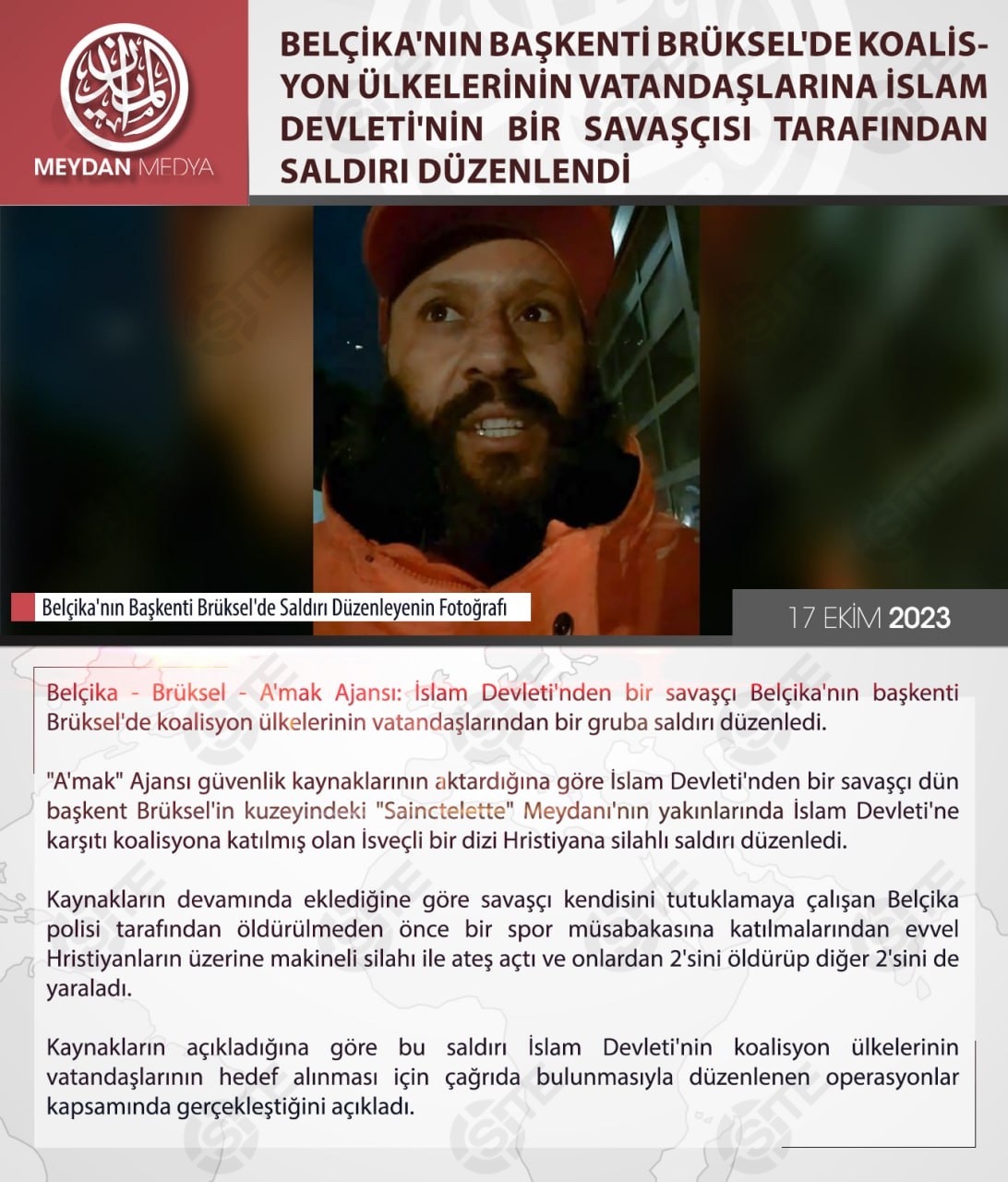

Statement from ISIS’ ’Amaq News Agency on the Brussels attack, which was translated into at least 13 languages.
“The recent attack in Brussels was a new reminder for the polytheists of Europe and their allies in America that, Allah willing, the attacks of the soldiers of Islam against them will not stop,” read a pro-ISIS poster celebrating the event.
Issues 413 and 414 of an-Naba further praised the Brussels attack as “restor[ing] the atmosphere of terror for the Crusaders” and instructed Muslims to kill Jews anywhere—“especially Jewish neighborhoods in America and Europe”— while also targeting embassies. It didn’t matter if ISIS’ incitements mentioned Palestine by name or not; the anger and energy across the West was ripe to steer toward attacks against the group’s limitless scope of enemies. As such, ISIS continued to rally its supporters.
Meanwhile, ISIS-linked media groups and communities have kept the fire going. Supporters have suggested poisoning Jews via food courier services while one magazine linked to ISIS’ Khorasan Province contained a detailed infographic on “Practical Ways to Confront the Jew,” based on content from an-Naba 413.

Infographic in issue of ISIS-linked “Voice of Khurasan” magazine.
Within this environment, the imminent threat SITE identified out of Las Vegas was unsurprising, as was another days later in France. Tragically, this latter plot was not intercepted.
On December 2, a man in Paris killed one and injured two others in a knife and hammer attack. Shortly after, a video surfaced showing the suspect, Armand Rajabpour-Miyandoab, pledging allegiance to ISIS. He exclaimed in part:
A message to you, O filthy disbelievers, know that the supporters of the Caliphate are in your backyard, and we have not forgotten you. By Allah, we have not forgotten your crimes against Muslims in our lands, especially against women and children…We fight you and we will fight you until the Day of Resurrection, despite your noses and others, by the permission of Allah.
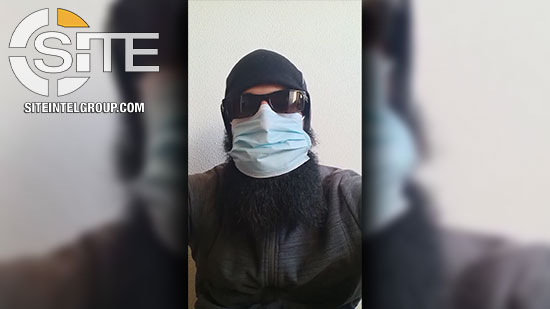
Video of Armand Rajabpour-Miyandoab pledging allegiance to ISIS.
This ISIS campaign—and the attacks it is evidently fueling—is creating deep worries among Western intelligence agencies. Authorities in Austria, Germany, and Spain have been on high alert following the recent arrests of ISIS-affiliated Tajiks, who were allegedly plotting attacks on cathedrals in several cities. Extra security has since been implemented at sites like Cologne Cathedral.
Thus, it is not hyperbole to say that there are life-or-death stakes in how diligently tech companies moderate their platforms.
Indeed, authorities must do their part to detect and neutralize such plots. However, an equal duty must be placed upon the tech sector to keep lone wolf-inspiring propaganda out of circulation. The free dissemination of ISIS propaganda online was foundational to the environment we saw across the mid- to late-2010s, when ISIS-attacks were commonplace and often virtually impossible to detect. As I detailed in my recent book, Saints and Soldiers, it was “no coincidence that as its social media presence deteriorated, so too did ISIS-inspired attacks in the West…attacks in the West went from roughly fourteen in 2017 to seven in 2018, and then just a couple a year ever since.”
Thus, it is not hyperbole to say that there are life-or-death stakes in how diligently tech companies moderate their platforms. Telegram’s inaction alone has already proven harmful as Hamas leverages it toward its massive propaganda operation. And while Hamas and ISIS might be opposed, it is only logical to presume that the imagery and narratives strewn across the Internet by the former are only feeding into the attack incitements by the latter.
ISIS’ infectious model of terrorism relied on an easily replicable model, by which any supporter can carry out an attack and be officially canonized by ISIS as one of its “soldiers.” By its very design, this model of terrorism can resurface all too easily, given the right circumstances. With the Israel-Hamas war fueling unrest and anger across the world—all while ISIS continues to exploit any Internet venue it can find—it seems the West may suffer these threats once more should circumstances not change.

Rita Katz
Executive Director & Founder
Rita Katz is the founder and Executive Director of SITE Intelligence Group. She has tracked and analyzed global terrorist networks for decades and is well-recognized as one of the most knowledgeable and reliable experts in the field. She has infiltrated terrorist fronts, testified before Congress in terrorism trials, and briefed officials at the White House and Cabinet.
Ms. Katz has authored two acclaimed books on terrorism, Saints and Soldiers (Columbia University Press, 2022) and Terrorist Hunter (Harper Collins, 2003). To learn more about Rita Katz and SITE Intelligence Group, click here.






